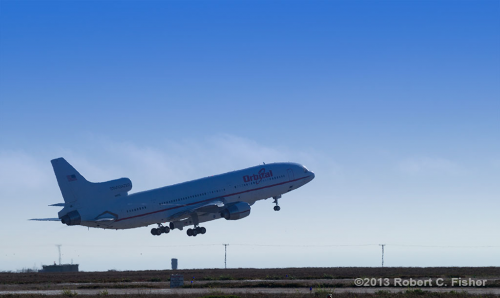
Following a 24-hour delay, Orbital Sciences Corp. successfully boosted its Pegasus-XL air-launched rocket aloft Thursday, 27 June on a mission to deliver NASA’s Interface Region Imaging Spectrograph (IRIS) payload into a polar, Sun-synchronous orbit at an altitude of approximately 400 miles. Originally scheduled for launch Wednesday night, the first attempt was scrubbed Tuesday by the effects of an electrical outage at Vandenberg Air Force Base, Calif., which damaged power systems at the U.S. Air Force Western Range Control Center. Repairs were completed and Wednesday afternoon the standard Launch Readiness Review confirmed that power had been restored and established the new launch target of Thursday, 27 June.
IRIS arrived at Vandenberg in mid-April, by which time the three stages of its Pegasus-XL booster had already been integrated. By the end of the month, the small satellite was electrically connected to the booster, preparatory to four extensive mission simulations during the next few weeks. On 30 May, IRIS was mounted atop Pegasus-XL and the two-piece payload fairing was installed shortly thereafter. Last Tuesday, a Flight Readiness Review concluded with a unanimous “Go” to proceed with the final steps toward a launch on 26 June. Those steps included mounting Pegasus-XL underneath the L-1011 fuselage on Wednesday 19 June and a Combined Systems Test to verify the integrated performance of the booster, the aircraft, and the payload on Thursday 20 June. All appeared to be proceeding normally until the decision to postpone Wednesday’s launch attempt by 24 hours.
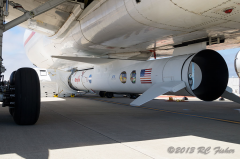
Weather conditions on the West Coast on Thursday evening were predicted to be 80-percent favorable, with only a slight chance of low cloud conditions threatening the departure of the L-1011 carrier aircraft from Runway 12/30 at Vandenberg. At 2:30 p.m. PDT (5:30 p.m. EDT) Thursday, launch personnel began the final preparations for the mission and the L-1011—a converted Lockheed aircraft, purchased by Orbital from Air Canada, back in 1994—took off at 6:27 p.m. PDT (9:27 p.m. EDT). To achieve the Pegasus deployment, the L-1011 crew was required to reach a three-dimensional point at approximately 36.0 degrees North by 123.0 degrees West, some 70 miles southwest of Monterey, over the Pacific Ocean.
Mounted beneath the L-1011’s fuselage, the 58-foot-long winged rocket was deployed at 7:27 p.m. EDT (10:27 p.m. EDT) at an altitude of about 39,000 feet. After a five-second period of free fall, Pegasus ignited the first of its three solid-fueled stages to commence the 13-minute procedure of injecting the IRIS payload into low-Earth orbit. The Orion 50S first-stage engine burned for 73 seconds and achieved a peak altitude of more than 200,000 feet, with Pegasus’ 45-degree delta wing providing additional lift and tail-mounted fins enabling steering. By the time the Orion 50S burned out and separated, Pegasus had already reached the hypersonic velocities necessary for insertion of its payload into low-Earth orbit.
Next, the turn came for the Orion 50 engine of the second stage, which fired for 73 seconds and provided pitch and yaw controllability, whilst nitrogen thrusters on the third stage handled movements about the booster’s roll axis. Midway through the second-stage burn, Pegasus’ two-piece payload fairing was jettisoned and IRIS—an important NASA observatory to study the Sun—was exposed to the vacuum of space. Finally, in the wake of second-stage burnout and separation, the Orion 38 third-stage motor flared for 68 seconds to complete the delivery. The entire mission, from L-1011 deployment to insertion into preliminary orbit, took approximately 13 minutes. After IRIS separation, the third stage performed a collision avoidance maneuver, then “safed” itself by venting its remaining supply of nitrogen.
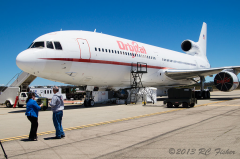
As a rocket, Pegasus’ air-launch capability makes it a unique asset, not least due to the fact that it can theoretically be deployed anywhere in the world. Since its maiden voyage on 5 April 1990—and including last night’s flight—the booster has flown 42 missions and is designed to transport payloads weighing up to 980 pounds into low-Earth orbit. The “extended” Pegasus-XL—which benefits from lengthened first and second stages to enhance payload performance—first flew in June 1994. Both that mission and its second, in mid-1995, failed, but since March 1996 it has enjoyed an almost unblemished record. Its most recent flight before last night’s launch, back in June 2012, successfully delivered NASA’s Nuclear Spectroscopic Telescope Array (NUSTAR) into orbit.
Over the years, Pegasus missions have been despatched from runways at Cape Canaveral Air Force Station, Fla., Dryden Flight Research Center at Edwards Air Force Base, Calif., Wallops Flight Facility in Wallops, Va., Gran Canaria Airport in the Canary Islands, and Bucholz Army Airfield in Kwajalein Atoll in the Marshall Islands of the Pacific Ocean. And therein lies another key advantage. Since the L-1011 carrier aircraft transports the booster to an altitude of around 39,000 feet, prior to deployment, crosswinds acting upon Pegasus are much gentler than they might be for a ground-launched rocket. Although meteorological conditions can still interfere with the initial takeoff and delivery to the deployment location, Pegasus is described as largely immune to weather-related delays when it reaches altitude.
The launch of IRIS has been a long time coming. It forms part of NASA’s Small Explorer program, with mission costs capped at $105 million and a mandate to provide frequent, low-cost access to space for heliophysics and astrophysics using small-to-mid-sized satellites. Four years ago, it was selected by NASA from six Small Explorer candidates and in June 2010 the space agency awarded Orbital a $40 million contract to launch it aboard Pegasus. Originally baselined to fly in December 2012, the IRIS launch has slipped several times, first into February, then April/May, and finally late June 2013.
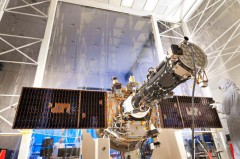
Standing seven feet tall, IRIS was built and integrated by Lockheed Martin Solar and Astrophysics Laboratory, upon whose shoulders the role of operating the mission will fall jointly with NASA’s Ames Research Center of Moffett Field, Calif. The satellite features a single scientific instrument—an 8-inch ultraviolet telescope, provided by the Smithsonian Astrophysical Observatory, coupled with a high-frame-rate, multi-channel imaging spectrograph—and seeks to observe how solar material moves, gathers energy, and heats up as it travels through a little-understood region of the Sun’s lower atmosphere.
In addition to providing solar physicists with greater awareness of the physical dynamics of our parent star, the two-year IRIS mission may help to explain what causes coronal mass ejections, which are primarily responsible for “space weather” and historically have demonstrated their ability to produce negative effects on terrestrial technologies and Earth-circling satellites. IRIS is the first mission to simultaneously observe conditions in the two regions closest to the Sun—the “chromosphere” and the “transition region”—which form a violently dynamic area in which hot and cold plasma are mixed over a range of altitudes.
“This location is where one of the most mysterious occurrences on the Sun takes place,” explained NASA on its IRIS webpage. “Usually, the closer you get to a heat source, such as a fire, the hotter it gets, but the solar atmosphere doesn’t do that. The solar atmosphere gets hotter as it gets further away from the Sun, and scientists don’t yet have enough information to distinguish between various theories on why this happens.” Indeed, the temperature changes from 6,000 degrees Kelvin at the solar surface to almost 1,000,000 degrees Kelvin at the top of the transition region.
The Pegasus XL rocket utilizes ATK solid rocket motors in all three of its stages. The Utah-based aerospace firm also provided several other components to this mission.
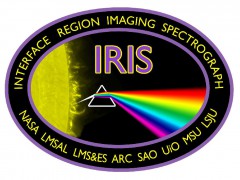
“IRIS will contribute significantly to our understanding of the interface region between the Sun’s photosphere and corona,” said Joe Davila, IRIS mission scientist at NASA’s Goddard Space Flight Center in Greenbelt, Md. “This region is crucial for understanding how the corona gets so hot.” Although temperatures continue to climb in the outermost region, the “corona,” IRIS’ attention will be upon the chromosphere and transition region, since they contain more material and the strongest heating is believed to occur there. It seeks to gather data on how the chromosphere regulates mass and energy to the corona, what types of non-thermal energy dominate it, and how magnetic fluxes and matter “rise” through the Sun’s lower atmosphere.
“With the high-resolution images from IRIS, scientists will be able to use advanced computer models to unravel how matter, light, and energy move from the Sun’s 6,000 Kelvin surface to its million Kelvin corona,” said Eric Ianson, IRIS mission manager at NASA-Goddard. “Scientists will be able to combine data from NASA’s IRIS and Solar Dynamics Observatory and the NASA/JAXA Hinode missions to obtain a more comprehensive understanding of the Sun’s atmosphere.”
The author would like to express his thanks to Robert C. Fisher for providing the Pegasus-XL and L-1011 flight imaging in this article.
Want to keep up-to-date with all things space? Be sure to “Like” AmericaSpace on Facebook and follow us on Twitter:@AmericaSpace
Missions » IRIS »



There are TWO polar orbits, north and south. Which was used, please? And what was the aircraft orientation, pitch angle, true airspeed and ground velocity, including track? These are all pieces of information of wide importance and interest.
And why 36N? I understood the earth’s rotation had to be cancelled for a polar orbit, and the higher the latitude the less there is.
Noel,
While you’re correct that this information is of interest, to say that it’s of “wide” interest – is inaccurate – at best.
Jason Rhian – Editor, AmericaSpace